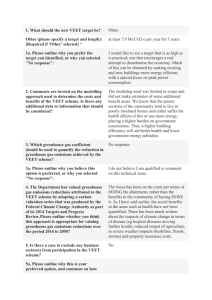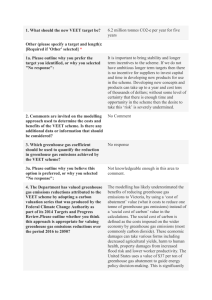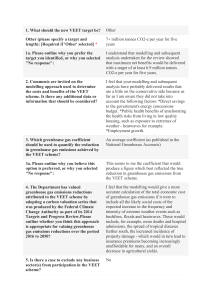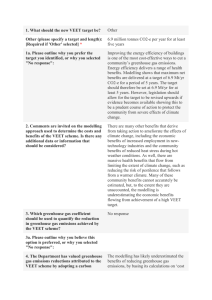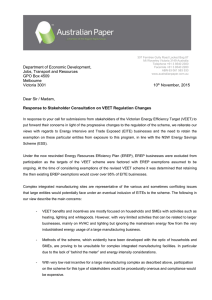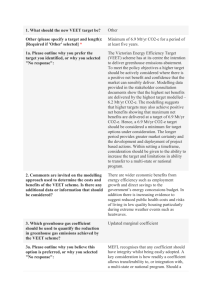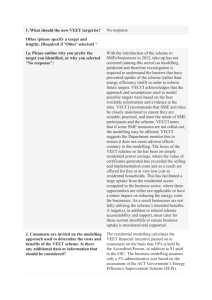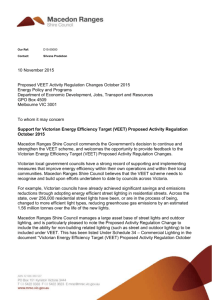Gardner Robin (DOCX 17.45 KB)
advertisement
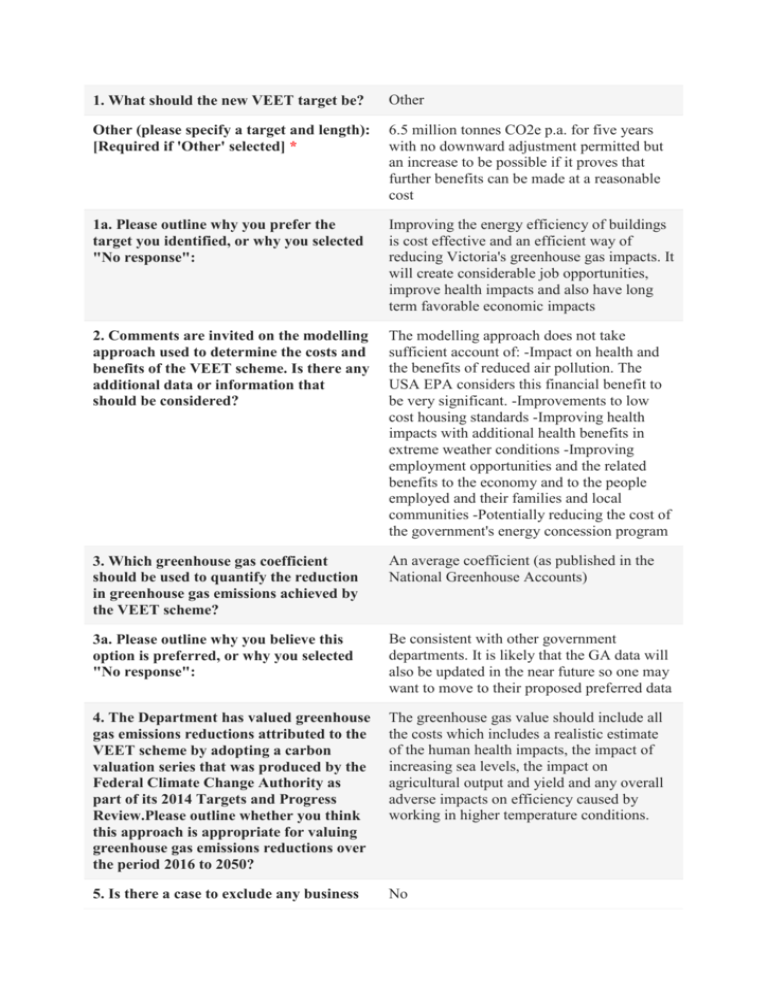
1. What should the new VEET target be? Other Other (please specify a target and length): [Required if 'Other' selected] * 6.5 million tonnes CO2e p.a. for five years with no downward adjustment permitted but an increase to be possible if it proves that further benefits can be made at a reasonable cost 1a. Please outline why you prefer the target you identified, or why you selected "No response": Improving the energy efficiency of buildings is cost effective and an efficient way of reducing Victoria's greenhouse gas impacts. It will create considerable job opportunities, improve health impacts and also have long term favorable economic impacts 2. Comments are invited on the modelling approach used to determine the costs and benefits of the VEET scheme. Is there any additional data or information that should be considered? The modelling approach does not take sufficient account of: -Impact on health and the benefits of reduced air pollution. The USA EPA considers this financial benefit to be very significant. -Improvements to low cost housing standards -Improving health impacts with additional health benefits in extreme weather conditions -Improving employment opportunities and the related benefits to the economy and to the people employed and their families and local communities -Potentially reducing the cost of the government's energy concession program 3. Which greenhouse gas coefficient should be used to quantify the reduction in greenhouse gas emissions achieved by the VEET scheme? An average coefficient (as published in the National Greenhouse Accounts) 3a. Please outline why you believe this option is preferred, or why you selected "No response": Be consistent with other government departments. It is likely that the GA data will also be updated in the near future so one may want to move to their proposed preferred data 4. The Department has valued greenhouse gas emissions reductions attributed to the VEET scheme by adopting a carbon valuation series that was produced by the Federal Climate Change Authority as part of its 2014 Targets and Progress Review.Please outline whether you think this approach is appropriate for valuing greenhouse gas emissions reductions over the period 2016 to 2050? The greenhouse gas value should include all the costs which includes a realistic estimate of the human health impacts, the impact of increasing sea levels, the impact on agricultural output and yield and any overall adverse impacts on efficiency caused by working in higher temperature conditions. 5. Is there a case to exclude any business No sector(s) from participation in the VEET scheme? 5a. Please outline why this is your preferred option, and comment on how this should be implemented: 5b. Please outline why this is your preferred option: Significant favorable impacts can be achieved by major businesses and the benefits will be significant. The system should apply, for large energy users, only to future projects (no back-dating) and be for incremental projects. These projects will give an overall positive economic benefit to the economy. 6. Should the VEET scheme be amended to better ensure support for low income households? Yes 6a. Please outline how the VEET scheme could better support low income households, and comment on why this option should be preferred: Low income households and rental properties generally are not satisfactorily covered by the proposed scheme. Methods to enable low income households to install good returning sustainable projects with the funding recovered over a number of years. Rental properties should be subject to minimum energy efficiency standards which would be progressively increased annually. Support could be provided in the form of information, advice and potentially funding with a multiple year payback 6b. Please outline why this is your preferred option: 7. In addition to expanding the range of energy efficiency activities available in VEET, should any other action be taken to target participation by certain groups? Yes 7a. Please outline the actions you believe should be taken: High energy consuming and relatively low income households (eg large family households) should be given access to advice, information and support and funding options. 7b. Please outline why no other action should be taken, or why you selected "No response": 8. Please suggest up to five activities that should be prioritised for revision or 1. Ceiling insulation including reducing the impact of gaps around lights. There is no introduction to the VEET scheme. Please outline why you believe these activities should be prioritised. longer a Federal scheme but ceiling insulation gives the best return and should be installed in a controlled and professional manner. It should include, wherever practical the replacement of halogen lights and therefore enable the insulation to safely cover almost all of the roof area. 2. Electric heat pumps are now more environmentally efficient than gas fired central heating and hot water heating units. The VEET allowance should be extended to these units and consideration given to reducing the benefits to gas fired units and incidentally any extensions to the reticulated gas system. 3. Commercial Lighting - there are substantial benefits available which are environmentally and economically viable and should be encouraged. 4. Street lighting should also be upgraded and could be an extension to the system. 5. Draught exclusion and sealing properties is environmentally and economically very worthwhile. The UK has introduced good systems to enable homes to be upgraded (particularly for low income and aged persons) without installer financial abuse. 9. Please suggest up to three changes which should be made to improve the VEET scheme. Please outline why you believe these changes should be a priority. A total house scheme which includes a comprehensive audit and a list of works covering all worthwhile sub-projects. Gives a good financial and environmental return quickly. Extending the support to lower income and rental sectors to enable sustainable projects to be implemented and the costs recovered over a reasonable period thereby improving the overall performance. Implement energy efficiency standards for rental properties and for smaller commercial premises with the results being publicised and required to be made available to new tenats. These standards to be progressively increased annually thereby improving the standard of the housing stock and improving overall performance. Encourage the commercial sector to implement more projects through improved support and schemes to make the financial impacts align better with their criteria.
